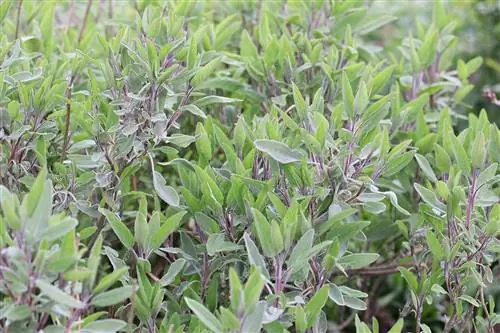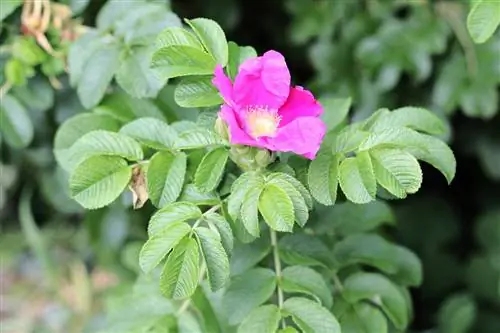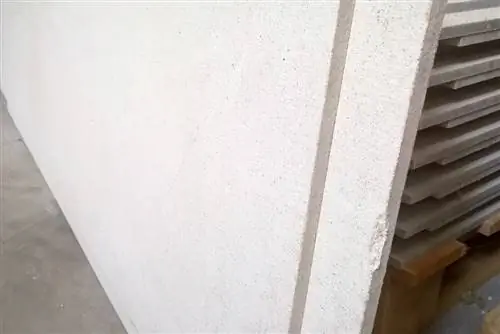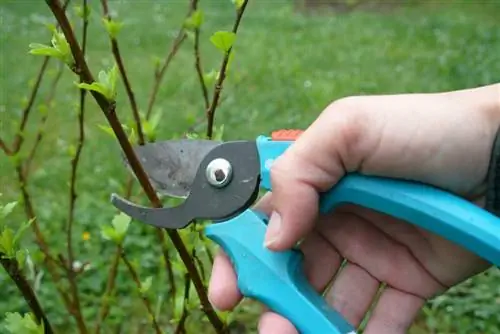- Author admin [email protected].
- Public 2023-12-17 03:39.
- Last modified 2025-01-24 12:45.
The honeysuckle, also known as honeysuckle, is an evergreen plant and is preferably used for greening facades, as a room divider in the garden or in the form of a hedge on the garden fence. Of the 180 known varieties of honeysuckle, Lonicera henryi has established itself as the most popular variety and stands out for its easy-care properties and its undemanding location.
Choose the right location
The perennial climbing plant appreciates a partially shaded location. The plant feels uncomfortable in full sun, but also in complete shade, and reacts with bare spots, slow or too fast growth and a lack of abundance of foliage. If only a predominantly sunny location can be found, the gardener should ensure that the root ball and base of the trunk are shaded. There are various ways to find an optimal location for the honeysuckle and to design the planting location so that there is no baldness on the main trunk. The gardener should:
- directly choose the partially shaded location
- or plant ground cover around the main trunk.
The demands on the soil are expressed in the need for:
- Nutrients
- Freshness
- Moisture.
If the honeysuckle is planted in nutrient-rich and moist soil, it will thank the choice of location with strong and dense growth. The gardener recognizes nutrient deficiencies when the honeysuckle develops very small leaves that are too light or tends to grow quickly but appear bare. Too much moisture or dryness in the soil can also become a problem and have a negative impact on growth.
Care and pruning
In addition to supplying the soil with nutrients and regularly checking for moisture, it is necessary to prune the honeysuckle at regular intervals. Pruning is recommended in spring and works:
- of the baldness
- the wild growth
contrary. When exposing should:
- dead and heavily woody shoots
- new shoots growing in undesirable directions
- long and bare growing shoots
removed generously. Even if the honeysuckle appears temporarily bare after it has been completely thinned out, pruning provides the optimal growth conditions and ensures strong and dense branching of the new shoots. The gardener should not prune during the summer growth phase. The months of April and May are best. Here the new shoots are already equipped with buds, so that the plant can be pruned in a planned manner and the growth can be directed in the desired direction. Planned fertilization should also be carried out during this time, although fertilizing about a week before pruning is most beneficial and enriches the soil with nutrients so that the pruned honeysuckle receives the optimal conditions for vigorous growth.
Propagate
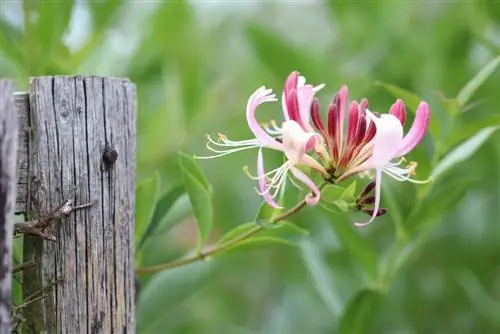
Propagate honeysuckle is easy and can be done using small cuttings. It is best to plan the desired propagation in combination with pruning. When it comes to cuttings, the gardener should:
- strong and he althy wood
- or choose shoots that are 10 centimeters long and not too soft
- and remove the lower leaves.
Root formation can, but does not have to, be accelerated in a glass of water. The cutting surface should be kept at an angle. If you want to plant the cutting immediately in its future location, you should dig a small hole and:
- fill half of it with nutrient-rich garden soil
- plant the cutting up to the base of the leaves
- press the soil lightly
- water
- spread the remaining soil over it
- and also press lightly.
A fresh cutting should not be fertilized or watered too heavily. After a short time, the honeysuckle cutting forms roots and develops new shoots.
Special features
With Lonicera you can choose attractive greenery for the facade. Since the shoots of the climbing plant do not stick to every masonry and could therefore grow in undesirable directions, trellises are an optimal solution and help for the honeysuckle. Grids or climbing nets are suitable for this, which the gardener attaches to the wall of the house and attaches the plant manually and very carefully to the climbing aid. The honeysuckle is a hardy and evergreen plant, but it has a special feature. In winter, the roots cannot absorb moisture, so the leaves can curl up or even fall off. However, the gardener does not need to worry that the honeysuckle will die. As early as spring, with the first rays of sunshine and warmer temperatures, the leaves roll up again or, if they have fallen, grow back again. Various honeysuckle varieties bloom from May to October and produce small, berry-shaped fruits that are barely visible to the naked eye. Young plants should be supported during wintering and the root ball should be covered above ground with bark mulch, and the young shoots should be covered with fleece to protect them from frost damage.
Pests and diseases
The honeysuckle is most often affected by aphids. But an infestation with bedbugs or leaf miners can also occur. The fact is that weakened plants are primarily attacked by pests and strong plants are usually spared. The choice of location for honeysuckle therefore plays a decisive role in its susceptibility to pests. The pest infestation can be recognized by:
- Dry spots
- Wool Formation
- honey or tar-like toppings
- dirty looking
Surfaces of the leaves. In general, it is advisable to take immediate action against the pest infestation and to completely remove particularly severely affected tendrils of the plant. This way you can avoid further spread and weakening of the plant.
The honeysuckle needs a place where it can climb. It is therefore particularly recommended for greening facades, but also for creating hedges or separating the terrace from the garden. It is undemanding and therefore requires little time to care for. Shady locations are preferred, as is moist but not waterlogged soil. The desired shape and full growth can be positively influenced by regular cutting in spring.
Care tips in brief
- It prefers semi-shady locations, but can also tolerate shade.
- If it is mainly in the shade, the plant often becomes bare from below. If the location is predominantly sunny, the base of the trunk should be shaded.
- The roots should always be covered. Ground cover plants are very suitable for this.
- The climbing plant loves nutrient-rich, fresh to moist garden soil. The soil can also be slightly acidic and humus.
- Waterlogging and dryness are harmful.
- Depending on the variety, the plant blooms from May to October, often unfortunately quite inconspicuously.
- The flowers are red-yellow, white-yellow, pink, reddish or yellow-orange in color and trumpet-shaped.
- Small blue-black or reddish berries appear as fruits. They are often eaten by birds. Some of them are slightly poisonous to humans.
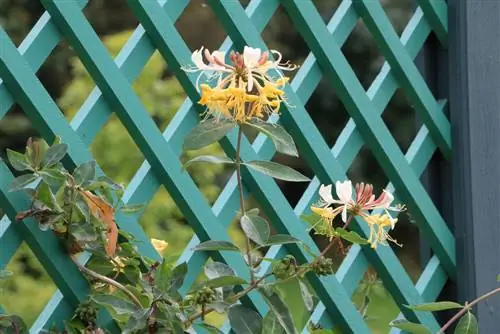
Vertical fan and net shapes are suitable as climbing aids. Cross elements and branches act as anti-slip protection and are conducive to a tight leaf wall.
Honeysuckle should be pruned occasionally in spring. This serves to thin out and promote branching. If there is a lot of baldness, cutting back into the old wood might help.
Propagation is done by cuttings and cuttings. Simply take a few shoots from a plant that are not too old and not too soft and cut these shoots to a length of about 10 cm. Remove the lower leaves and leave just a few at the top. The shoots are placed in a compost-sand mixture. After a few weeks roots should have formed. The plant begins to grow.


